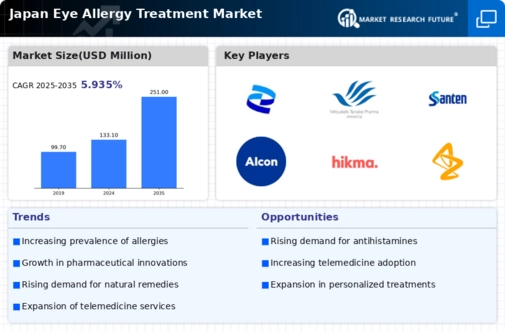The Japan Eye Allergy Treatment Market is characterized by a competitive landscape with several key players striving to capture market share through innovative products and strategic initiatives. The market is influenced by the rising prevalence of allergic conditions, including eye allergies such as allergic conjunctivitis, driven by environmental factors and lifestyle changes. Pharmaceutical companies are investing in research and development to introduce advanced therapies and treatment options. Additionally, partnerships and collaborations with healthcare providers are becoming increasingly significant as companies seek to enhance patient access to effective treatments.
Overall, the Japan Eye Allergy Treatment Market reflects a dynamic environment where competition is fierce, and companies are consistently looking for ways to differentiate themselves and meet the evolving demands of consumers.
Pfizer holds a notable presence in the Japan Eye Allergy Treatment Market, leveraging its robust research capabilities and extensive product portfolio. The company's strengths lie in its well-established global reputation and a diverse range of allergy-related medications that cater specifically to the needs of the Japanese population. Pfizer's commitment to innovation is reflected in its ongoing research efforts aimed at enhancing the effectiveness of eye allergy treatments. Additionally, its strong distribution network ensures that products are readily available to patients across Japan, contributing to improved market penetration.
The company's focus on patient education and awareness campaigns also bolsters its standing in the market, positioning Pfizer as a leader in providing comprehensive solutions for eye allergies.
Mitsubishi Tanabe Pharma has emerged as a key player in the Japan Eye Allergy Treatment Market, focusing on developing specialized therapies for allergic conditions. The company offers a range of products aimed at alleviating symptoms associated with eye allergies, emphasizing tailored solutions that resonate with the needs of Japanese patients. Mitsubishi Tanabe Pharma's strengths are rooted in its deep understanding of local market dynamics and consumer preferences, enabling it to create effective and targeted therapies. The company has engaged in strategic mergers and acquisitions to enhance its research capabilities and expand its product offerings.
Their commitment to improving patient outcomes is further demonstrated through collaborations with healthcare professionals and institutions in Japan, thereby reinforcing their market presence and ensuring they remain competitive in the evolving landscape of eye allergy treatments.





















Leave a Comment